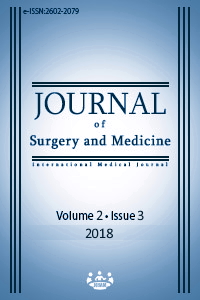The relationship between dialysis adequacy and the rate of change in uric acid level by hemodialysis
Keywords:
Dialysis adequacy, Urea kinetic model, Kt/V, Uric acidAbstract
Aim: Although one of the commonly used methods for determining dialysis adequacy is the urea kinetic model, it is not the gold standard. Different parameters are needed to determine dialysis adequacy. In our study, we investigated the relationship between urea reduction rate (URR) and Kt/V which are used to assess dialysis adequacy and the rate of change in uric acid, a purine metabolite, by hemodialysis.
Methods: A total of 133 patients who had undergone hemodialysis treatment due to renal failure between March 2010 and September 2010 were evaluated retrospectively. Urea kinetic modeling was used to measure dialysis adequacy. The following formula was used to do this; Kt/V=-ln(R-0.008xT)+(4-3.5xR)xUF/W[R; postdialysis blood ureanitrogen (BUN)/predialysis BUN, T; duration of dialysis (hr), UF; total ultrafiltration during dialysis (L), W; patient weight after dialysis (kg)]. The urea reduction rate was calculated using the formula; URR(%)=100x(1-postdialysis BUN/predialysis BUN). Uric acid reduction rate (UARR) was calculated using the formula; UARR(%)=100x(1-Uric acid after/Uric acid before). The relationship between URR and Kt/V ratios which are used to assess dialysis adequacy and UARR is evaluated.
Results: Median urea, uric acid and creatinine reduction rates were 72%, 74% and 63.9%, respectively. There was a statistically significant correlation between reduction rates of uric acid, creatinine and urea after dialysis (p<0.001). There was a statistically significant relationship between URR and Kt/V which are used to assess dialysis adequacy,and UARR (p<0,001). According to the ROC analysis in our study, we defined UARR value that will demonstrate dialysis adequacy as at least 65.8% (sensitivity 97.9% and specificity 82.6%, area under the ROC curve=0.880, p<0.001).
Conclusion: A significant relationship was found between the URR and Kt/V ratios which are used to assess dialysis adequacy and UARR. We also determined in our study that the UARR value that shows dialysis adequacy should be at least 65.8%. To our knowledge, this is the first study to evaluate the relationship between UARR and dialysis adequacy. However, thefindings need to be confirmed by large, prospective, clinical trials.
Downloads
References
Levey AS, Eckardt KU, Tsukamoto Y, Levin A, Coresh J, Rossert J, et al. Definition and classification of chronic kidney disease: a position statement from Kidney Disease: Improving Global Outcomes (KDIGO). Kidney Int. 2005;67(6):2089-100.
Meert N, Schepers E, De Smet R, Argiles A, Cohen G, Deppisch R, et al. Inconsistency of reported uremic toxin concentrations. Artif Organs. 2007;31(8):600–11.
Vanholder R, Meert N, Schepers E, Glorieux G, Argiles A, Brunet P, et al. European Uremic Toxin Work Group (EUTox) : Review on uraemic solutes II—variability in reported concentrations: causes and consequences. Nephrol Dial Transplant. 2007;22(11):3115–21.
Vanholder R, De Smet R, Glorieux G, et al. Review on uremic toxins: classification, concentration, and inter individual variability. Kidney Int. 2003;63(5):1934-43.
Heinig M, Johnson RJ. Role of uric acid in hypertension, renal disease, and metabolic syndrome. Cleve Clin J Med. 2006;73(12):1059-64.
Chen W, Roncal-Jimenez C, Lanaspa M, Gerard S, Chonchol M, Johnson RJ, et al. Uric acid suppresses 1 alpha hydroxylase in vitro and in vivo. Metabolism. 2014 Jan;63(1):150-60.
Sampol J, Dussol B, Fenouillet E, et al. High adenosine and deoxy adenosine concentrations in mononuclear cells of hemodialyzed patients. J Am Soc Nephrol. 2001;12(8):1721-8.
Simmonds HA, Cameron JS, Morris GS, et al. Purine metabolites in uraemia. Adv Exp Med Biol. 1987;223:73-80.
European Best Practice Guidelines Expert Groupon Hemodialysis, European Renal Association. Section II. Hemodialysis adequacy. Nephrol Dial Transplant. 2002;17(7):16–31.
Makita Z, et al. Efficiency of removal of circulating advanced glycosylation end-product sand mode of treatment in patients with ESRD. Am Soc Nephrol. 1992;3:335.
Eloot S, Torremans A, De Smet R et al. Kinetic behavior of urea is different from that of other water-soluble compounds: thecase of the guanidin ocompounds. Kidney Int 2005;67(4):1566–75.
Kalil RS, Carpenter MA, Ivanova A, et al. Impact of Hyperuricemia on Long-term Outcomes of Kidney Transplantation: Analysis of the FAVORIT Study. Am J Kidney Dis. 2017;70(6):762-9.
Zuo T, Liu X, Jiang L, Mao S, Yin X, Guo L et al. Hyperuricemia and coronary heart disease mortality: a meta-analysis of prospective cohort studies. BMC Cardiovasc Disord. 2016;16(1):207.
Braga F, Pasqualetti S, Ferraro S, Panteghini M. Hyperuricemia as risk factor for coronary heart disease incidence and mortality in the generalpopulation: a systematic review and meta-analysis. Clin Chem Lab Med. 2016;54(1):7-15.
Vanholder RC, De Smet RV, Ringoir SM: Assessment of urea and other uremic markers for quantification of dialysis adequacy. Clin Chem. 1992;38:1429–36,
De Smet R, Dhondt A, Eloot S, et al. Effect of the super-flux cellulose triacetate dialyser membrane on the removal of non-protein-bound and protein-bound uraemic solutes. Nephrol Dial Transplant. 2007;22(7):2006–12.
Fagugli RM, De Smet R, Buoncristiani U, et al. Behavior of non-protein-bound and protein bound uremic solutes during daily hemodialysis. Am J Kidney Dis. 2002;40(2):339–47.
Basile C, Libutti P, Lucia A, Casino G.F, Vernaglione L, Tundo S, et al. Removal of uraemic retention solutes in Standard bicarbonate haemodialysis and long-hours low flow bicarbonate haemodialysis. Nephrol Dial Transplant. 2011; 26(4):1296-303.
Vanholder R, DeSmet R, Lesaffer G. Dissociation between dialysis adequacy and Kt/V. Semin Dial. 2002;15(1):3-7.
Fotbolcu H, Duman D, Ecder SA, Oduncu V, Cevik C, Tigen K, et al. Attenuated cardiovascular response to sympathetic system activation during exercise in patients with dialysis-induced hypotension. Am J Nephrol. 2011;33(6):491-8.
Aon MA, Cortassa S, Maack C, et al. Sequential opening of mitochondrial ion channels as a function of glutathione redox thiol status. J Biol Chem. 2007;282(30):21889-900.
Shinzato T, Miwa M, Nakai S, et al. Role of adenosine in dialysis-induced hypotension. J Am Soc Nephrol. 1994;4:1987-94.
Downloads
- 1616 1767
Published
Issue
Section
How to Cite
License
Copyright (c) 2018 Oktay Bozkurt, Cevat Topal, Mevlüde İnanç
This work is licensed under a Creative Commons Attribution-NonCommercial-NoDerivatives 4.0 International License.















